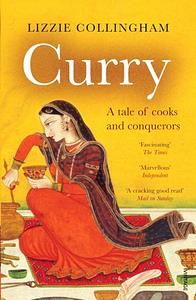Take a photo of a barcode or cover
I liked this book a great deal. It's a nice overview of foreign influence on Indian food, from the Mughals to the British. Of course, one cannot simply list "and they borrowed this from them" and have anything compelling. The book is a combination of the more "important" history (your landings, invasions, and politics) and the attendant cultural change - seen so strongly in the foods one adopts or fails to adopt from a foreign land. Collingham is a good writer and the book flows well. Very, very enjoyable.
There's also a nice little collection of recipes, from simple mango lassi to much more complicated dhansak.
There's also a nice little collection of recipes, from simple mango lassi to much more complicated dhansak.
funny
informative
lighthearted
medium-paced
Dense and occasionally complex to follow, this is an interesting cultural history of Indian food. It clearly demonstrates that any attempt to reconstruct "authentic" cuisines is ultimately silly. Several bits from the book stick out in my mind. Chai was developed because the British were attempting to encourage Indians to consume tea; Chai actually undermined it because it used less tea than the conventional forms. Now, we are sold Chai as an authentic Indian drink.
But, most pointedly perhaps, is the story of Madhur Jaffrey, who never cooked in Delhi when she lived there, and learned while living in London from instructions sent by her mother, adapting Indian recipes to available British ingredients. She became an Indian cookbook author only after moving to the U.S., while pursuing a career as an actress. While acting in India, she was hired by the BBC to do a cooking show in the 70s, which was later aired in India to teach Indians how to cook their "national" dishes. A truly fascinating world story.
But, most pointedly perhaps, is the story of Madhur Jaffrey, who never cooked in Delhi when she lived there, and learned while living in London from instructions sent by her mother, adapting Indian recipes to available British ingredients. She became an Indian cookbook author only after moving to the U.S., while pursuing a career as an actress. While acting in India, she was hired by the BBC to do a cooking show in the 70s, which was later aired in India to teach Indians how to cook their "national" dishes. A truly fascinating world story.
A history of food, individual foodstuffs and foreign rule in India (both Mughal and British), and the influence it has had on Indian and Indianesque cooking. Maybe there could have been a bit more history of the last generation or two, but that aside I really enjoyed this!
I learned a lot about Indian and British history, picked up some cooking ideas and was immensely entertained by this book, which is liberally sprinkled with recipes and illustrations. Highly recommended.
This book is fascinating. I learned a lot about the history of Indian food in India and around the world. The book provides a lot to talk about with friends! I would give it five stars except that most of the recipes given are not ones you would really try. There are a few that are feasible but most of them are incomprehensible,
(but interesting!)to the modern cook.
(but interesting!)to the modern cook.
This was a perfect end-of-summer book. True, it's an academic work, but it's fun, interesting and quite the page-turner. The book is divided into chapters that focus on a different "Indian" dish -- vindaloo, korma etc. -- and carefully pieces together how the dish was first created, when it became popular and the historical background surrounding the dish's introduction. It's a fascinating look at the history of India, the history of food, and how the food most people recognize as "Indian food" isn't what Indians were eating 400 or 500 years ago. For example, the potato was a latecomer to Indian cuisine (I can't imagine Indian food without the ubiquitous aloo) and even the chili came to India via the Portuguese. My only gripe is that the food of South India -- the region where my family comes from -- is barely touched on, partially because the British and other conquerors did not really assimilate South Indian cooking into their diet.
informative
reflective
medium-paced
adventurous
emotional
reflective
slow-paced
Lovely way to read about history - though food.






